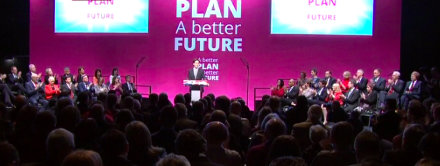

by Tim Bale, Paul Webb and Monica Poletti
At elections, a good ground game may not be everything but it still means something. In a tight race, it may even mean the difference between a party winning and losing. But, if “boots on the ground” are at least potentially important, who is it who wears them and why? And what exactly do they do once they’ve put them on?
The answer to the first question has traditionally been obvious: grassroots members of political parties. The answer to the second no less so: delivering leaflets, putting up posters, holding meetings, canvassing voters, and perhaps even standing for election.
But what if all this no longer holds? After all, until very recently anyway, the number of people joining political parties was falling as fast in the UK as it’s been falling all over Europe. We’ve also seen the rise of new communication technologies and social media. As a result, both who campaigns and what they do when they’re campaigning may well have changed – something that’s worth considering as Labour embarks on its campaign for the local elections in May.
Drawing on survey data collected for our ESRC-funded party members project a week or two after the 2015 general election, we have been able to investigate the differences and similarities in campaign activity at that election between, on the one hand, Labour members and, on the other, people who strongly identified with the party but who hadn’t actually joined it – people we will call Labour-supporting non-members.
First off, we looked to see if there were demographic differences – and, as you can see from Table 1, there certainly were. Paid-up Labour members in 2015 weren’t on average any older than Labour-supporting non-members, but they were much more likely to be men, to be graduates and to be middle class. They were also likely to think of themselves as slightly more left-wing.
Interestingly, taking members and supporters of all six parties we surveyed (Labour, the Conservatives, the Lib Dems, the Greens, UKIP and the SNP), more advanced number-crunching suggests that, in common with being socially liberal and/or living in a marginal seat, being a woman was associated with doing more for your party at election time. We’re not quite sure why, but suggestions are always welcome!
Table 1: 2015 Labour members and Labour supporting non-members: demographics and ideology
| Members | Lab-supporting non-members | |
| Average Age | 51 | 52 |
| Male/Female split | 62/38 | 50/50 |
| Percentage of graduates | 56 | 30 |
| Percentage in ABC1 group | 70 | 52 |
| Mean left (0) – right (10) placement | 2.4 | 3.0 |
When we looked in detail at what people actually do – or at least what they claim to have done – during the election campaign, we found that the old favourites – like putting up a party poster in your window – haven’t yet died a death, even though people are also campaigning online as well as offline, see table 2. We also find that party members are still far more likely to campaign (or at least claim to have campaigned) for their parties than are non-member supporters. Moreover, this is especially true – even discounting for over-claiming – when it comes to more intensive forms of activity – things like leafleting.
Table 2: Labour members and Labour-supporting non-members: reported campaign activity at the 2015 general election
| Members | Lab-supporting non-members | |
| % | % | |
| Liked something on FB | 51 | 19 |
| (Re)tweeted something on twitter | 37 | 8 |
| Displayed an election poster | 51 | 11 |
| Delivered Leaflets | 43 | 3 |
| Attended public meeting | 31 | 5 |
| Canvassed in person or by phone | 36 | 2 |
That said, it is vital to bear in mind that, barring a complete electoral meltdown, there will always be many more people out there in the electorate who aren’t members but who strongly support Labour than there will be members. As a result, the sum total of campaign activity they undertake is almost bound to be as great, if not greater, that of party members. Indeed, by using data from the British Election Study to gauge (a) the number of strong Labour identifiers out there in the electorate and creating (b) an “activism index”, a measure of how many of the various campaign activities on offer that each person undertook, we can by subtracting any Labour members from (a) so as to avoid double-counting and then multiplying (a) by (b) so as to estimate their relative contributions in 2015, see table 3.
Table 3: Estimating the relative campaign contribution of party members and Labour-supporting non-members at the 2015 general election
| Members | Labour-supporting non-members | ||||||||
| Estimated numbers nationally | 188,000 | 3,883, 464 | |||||||
| Activism index | 2.56 | 0.48 | |||||||
| Mean number of campaign activities (weighted by size of group) | 481,280 | 1,864,063 | |||||||
As is obvious from the table, Labour, which has made much in the last year or so of its growing membership, should recognise, as should other parties, that its strong supporters out there in the electorate are a significant organisational and human resource. It might also be worth the party noting that they are almost certainly more representative of Labour voters – and indeed voters as a whole – than its paid-up members.
On the other hand, those members remain absolutely vital for campaigning. For one thing, they are clearly much more ready to undertake the hardest tasks, or at least they were back in May 2015. For another, they may well be important as facilitators and motivators of the efforts of those voters who support Labour and may be willing to help it out at election time but who haven’t gone so far as to actually join the party.
Finally, though, a word of caution. Our surveys suggest that, put together, Labour members and supporters did – or at least claimed to have done – significantly more work for their party than their Tory counterparts in 2015. Yet the Tories beat Labour hands-down. In short, members and supporters matter; but they can’t make up for a message – or a leader – that voters simply don’t warm to.
Tim Bale and Monica Poletti are based at Queen Mary University of London and Paul Webb is based at the University of Sussex.




More from LabourList
Five Brent Labour councillors quit party and defect to Greens
NEC election timelines, party management and challenges ahead – Ann Black’s Labour NEC report
Labour’s identity crisis – caught between Blairism and Blue Labour